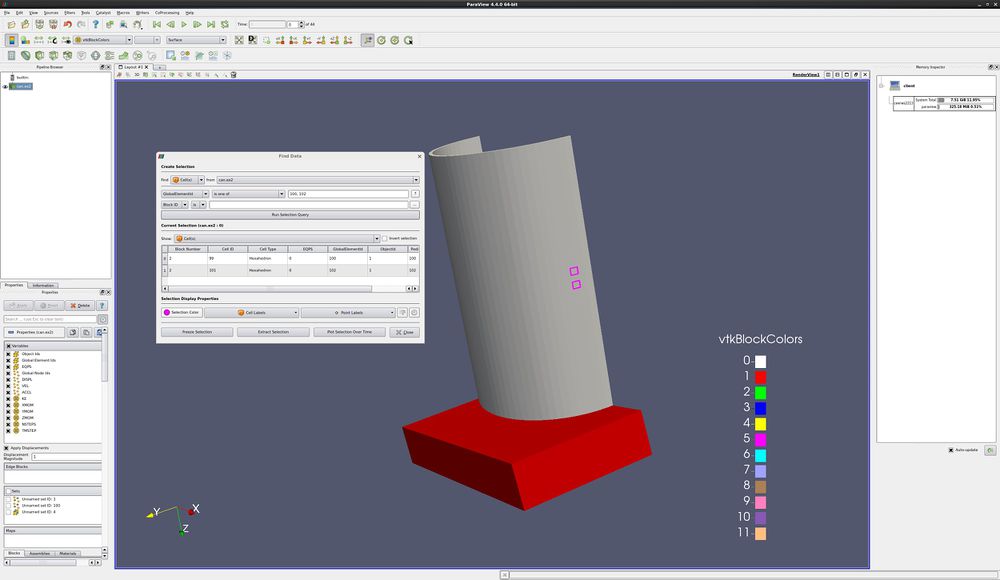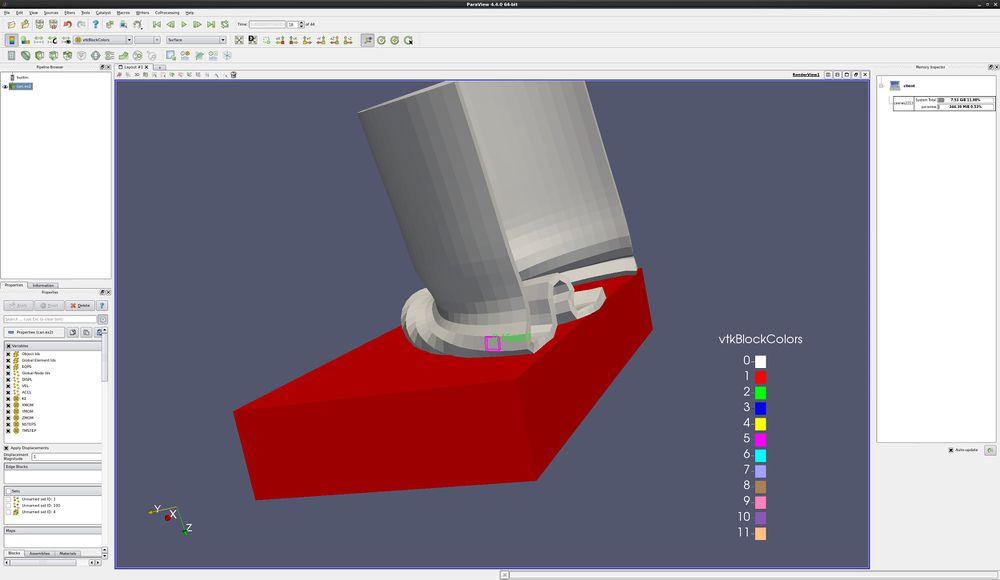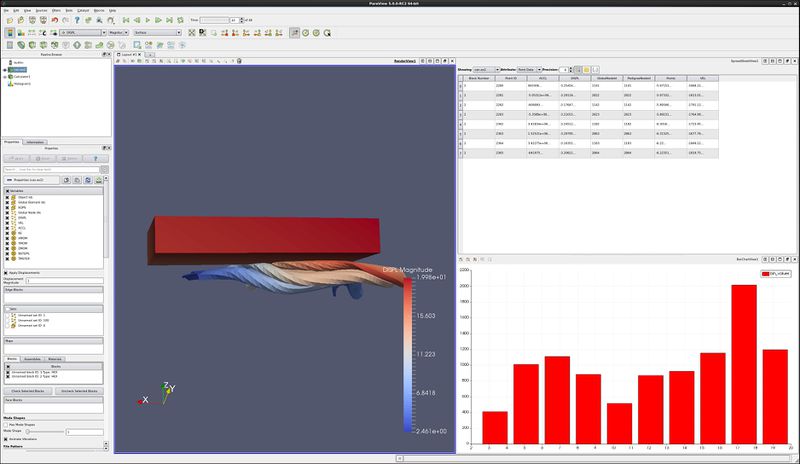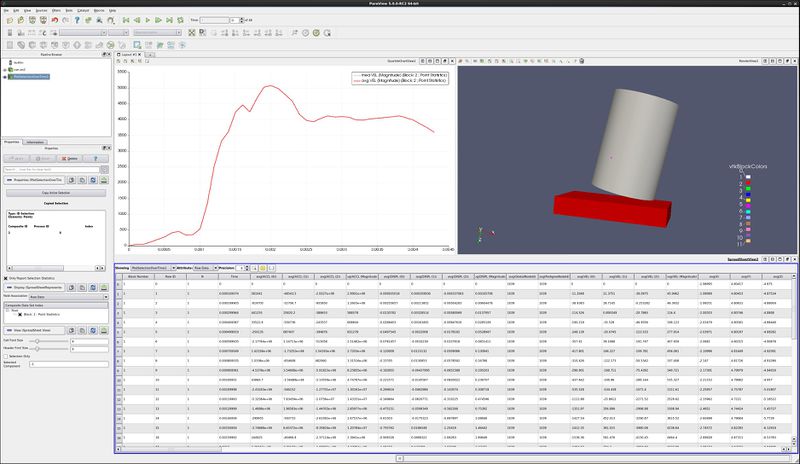Advanced Data Analysis
Introduction
This tutorial covers data analysis.
Find Data dialog
The Find Data dialog box is used to select points or cells, to show the data for these points or cells, to control label display on your data in the 3d view, and as a shortcut to run data analysis filters. We will explore this dialog box using an example.
- Open a dataset and the Find Data dialog.
- Open the dataset can.exo. Turn on all variables. Apply.
- Edit/ Find Data. You can also open the Find Data dialog using the icon Error creating thumbnail: Unable to save thumbnail to destination
- We will select a GlobalElementId.
- Find Cells from can.ex2
- Change pulldown to GlobalElementId. Leave as is. Enter 100.
- Run Selection Query
- We will select two GlobalElementIds.
- Find Cells from can.ex2
- Change pulldown to GlobalElementId. Change to is one of. Enter 100, 102.
- Run Selection Query
- We will select the maximum EQPS.
- Move forward one timestep. EQPS for timestep 0 is all the same - 0.
- Find Cells from can.ex2
- Change pulldown to EQPS. Change to is max.
- Run Selection Query
- Play forward
Notice that the data for the selected cell (or point) is displayed in the spreadsheet.
If desired, the maximum (or minimum) cell can be found, and this selection can be frozen. The same cell will then be selected for all timesteps. Use the Freeze Selection button to freeze selections.
We can also display cell or point data on the 3d view. This is done with Cell Labels and Point Labels.
- Open the Cell Labels pulldown, and select EQPS.
Data Analysis - Spreadsheet and histogram view
- Open Can.exo.
- Highlight the can window, and Select Cell on the can.
- Split Horizontal
- Split Vertical
- In the upper right window, select Spreadsheet View.
- Change the Attributes to Cell Data. Return it to Point Data.
- Select the Show Only Selected Elements check box (next to Precision).
- Note that the Spreadsheet can now be sorted - including in parallel.
- Select a different cell on the can.
- Highlight the lower right window.
- Filters→Data Analysis→Histogram. Apply.
- Change Scalars to DISPL. Apply.
- Animate forward in time one step at a time.
- Play
Data Analysis - Advanced Spreadsheets
- You can either display all of your dataset's points or cells in your spreadsheet, or only those that are selected in the 3d view. With the spreadsheet window selected, on the Display tab, click Show only selected elements.
- When cells or points are selected in the 3d window, the appropriate row(s) in the spreadsheet view will be highlighted.
- Highlighting works both ways - if you select a row or rows in the spreadsheet view, the cell or point on your dataset will be selected.
- You can select multiple rows in the spreadsheet by holding down the <ctrl> key, and can select ranges of rows by holding down the <shft> key.
- Note that the Spreadsheet can now be sorted - including in parallel.
Data Analysis - Frustrum
- When you are using the Select Cells Through or Select Points Through, it is possible to see the frustrum (the 3d space you selected). Turn on View/ Selection Inspector , then Selection Type - Frustrum, then click the Show Frustrum check box.
Data Analysis - Extract Selection
- Open can.exo.
- On the toolbar, push the Select Cells On icon. This will allow you to manually select a cell on your data set.
- Click on the can in one location, turning on only one cell.
- Filters→Data Analysis→Extract Selections, then click the Copy Active Selection button, and Apply.
- Split Vertical, Spreadsheet View, and turn on the eyeball in front of the ExtractSelection filter.
- You can see Cell data by selecting the ExtractSelection→Display tab and changing the Select Attributes to Show.
- Try animating the data.
- Extra Credit: Turn on visibility of the can, and display it in wireframe. Change the color of the selected cell to Red. (The following picture is including the extra credit.)
Data Analysis - Spreadsheet data by time
- Open can.exo.
- On the toolbar, push the Select Points On icon. This will allow you to manually select a point on your data set.
- Rubber band select a point, turning on only one point.
- Filters→Data Analysis→Plot Selection Over Time, then click the Copy Active Selection button, and Apply.
- Split Vertical, Spreadsheet View, and with the Spreadsheet View highlighted, turn on the eyeball in front of the PlotSelectionOverTime filter.
- Note that you can then write this data out to a .csv file using File → Export.
Acknowledgements
Sandia is a multiprogram laboratory operated by Sandia Corporation, a Lockheed Martin Company, for the United States Department of Energy’s National Nuclear Security Administration under contract DE-AC04-94AL85000.




